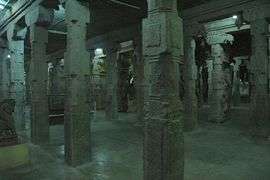Ariyanatha Mudaliar
Ariyanatha Mudaliar was the Delavoy (General) and the Chief Minister of the greatest of the Nayaka domains established by the Vijayanagar viceroy and later ruler of Madurai, Viswanatha Nayak (1529–64). He assisted in running a quasi-feudal organisation of regions called the poligar or the palayakkarar system where the regions are divided into palayams (small principalities) and are independently governed by poligars or palayakkarars (petty chiefs).[1]
The Aiyaram Kaal Mandapam, or Thousand Pillared Hall, in the famous Meenakshi Temple was constructed by him in 1569. There is a statue of him at the entrance.[2]
Early life
Ariyanatha Mudaliar was born in Meippedu village, Tondaimandalam (the present day Kanchipuram district). According to a modern descendant, he learned Tamil and Mathematics from a teacher for free and in his spare time mastered the ancient Tamil martial art of Silambam and others like sword fight and wrestling. At the age of 16, he was encouraged to go the court of Krishnadevaraya, the king of Vijayanagara. Ariyanatha soon rose to prominence and became the chief accountant of the Vijayanagara empire.[3]
Rise to power

The process of consolidation of the Tamil region under the Vijayanagara empire began at the start of the 16th century. The regions were brought primarily under the control of the Nayaka kingdoms of Madurai, Tanjore and Senji. Though the different Nayaka regions were autonomous, they all acknowledged the sovereignty of the Vijayanagara and its emperor, Krishnadevaraya.[4]
During the process of consolidation, Krishnadevaraya dispatched one of his most successful generals, Nagama Nayaka, on a campaign to punish Virasekhara Chola who had plundered the petty Pandyan regions. The Pandyas were under the protection of the Vijayanagara empire. Having put down Virasekhara, the general Nagama Nayak claimed Madurai for himself. Viswanatha Nayak, the son of Nagama Nayak, was more loyal to the king Krishnadevaraya than to his father. He overthrew his father and handed him over to Krishnadevaraya and as a reward for his loyalty the king appointed Viswanatha Nayaka as the governor of Madurai and other provinces in the neighbouring Tamil country.[5]
Viswantha Nayak was succeeded by his son, Krishnappa Nayak, who together with Ariyanatha expanded the Nayak's Madurai kingdom and brought most of the ancient Pandyan territory under its rule.[5]
References
- Bayly, Susan (2004). Saints, Goddesses and Kings: Muslims and Christians in South Indian Society, 1700–1900 (Reprinted ed.). Cambridge University Press. p. 48. ISBN 978-0-52189-103-5.
- History&Description of Sri Meenakshi Temple: By T. G. S. Balaram Iyer, T. R. Rajagopalan – Meenakshi Temple – 1977
- "Inspired by a house of 1,000 windows". The Hindu. 4 April 2008. Retrieved 24 February 2015.
- Mukund, Kanakalatha (1999). The Trading World of the Tamil Merchant: Evolution of Merchant Capitalism in the Coromandel. Orient Blackswan. ISBN 978-8-12501-661-8.
- The New Cambridge History of India By Gordon Johnson, Christopher Alan Bayly, J. F. Richards